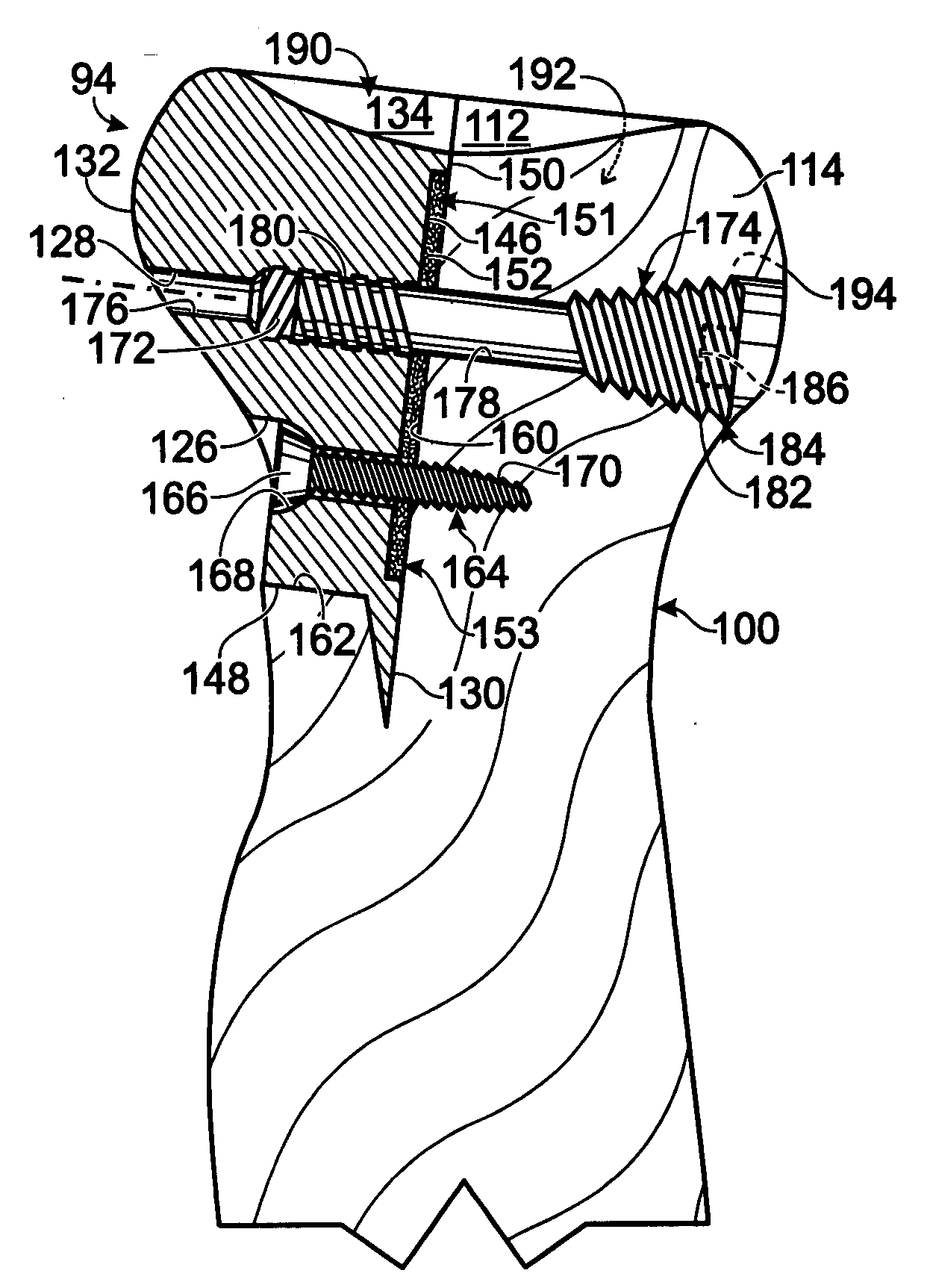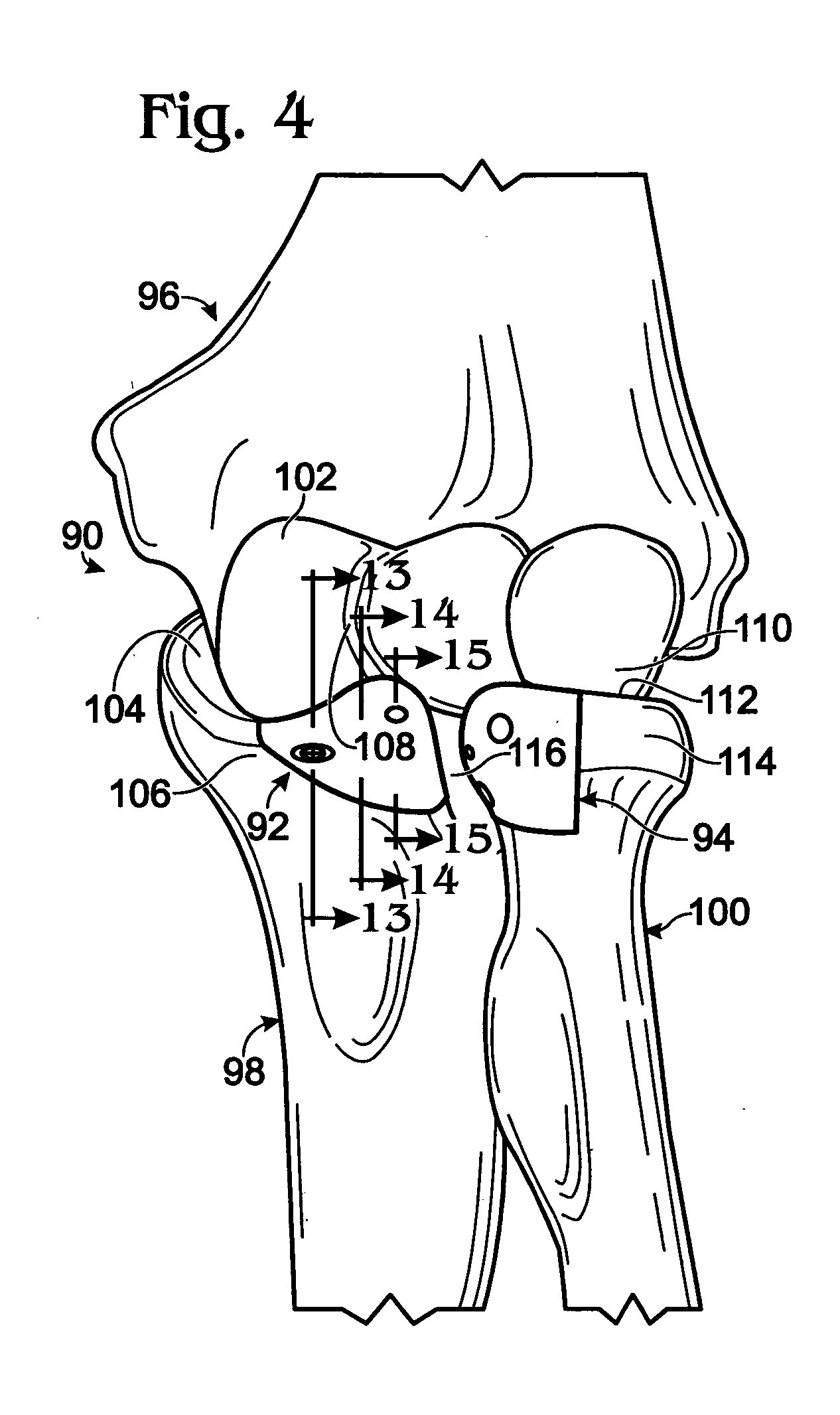Prosthesis for partial replacement of an articulating surface on bone
a technology for articulating surfaces and bone, applied in the field of prosthesis for partial replacement of articulating surfaces on bone, can solve the problems of joint dysfunction, injury to movable joints, difficulty in repair,
- Summary
- Abstract
- Description
- Claims
- Application Information
AI Technical Summary
Problems solved by technology
Method used
Image
Examples
example 1
Prosthesis for Partial Radial Head Replacement
[0057] This example describes the structure and installation of exemplary partial radial head prosthesis 94; see FIGS. 4-8.
[0058]FIGS. 5-7 show partial radial head prosthesis 94 of FIG. 4 in isolation from the bones of left elbow 90. Partial radial head prosthesis 94 may include a body 120 having a proximal head 121 and a distal neck 122. The head and neck may define an outer surface 123 and an inner surface 124. The body also may define a plurality of openings or holes 126, 128 for receiving fasteners. A prong 130 may be connected to the body, for example, extending from a distal region of inner surface 124. In alternative embodiments, the prong may be a stem configured to extend into a natural bone cavity, such as the medullary canal.
[0059] Outer surface 123 may include a plurality of spaced surface regions 132, 134 for articulation with the ulna and the humerus, respectively. Lateral or side surface region 132 may be configured to ...
example 2
Prosthesis for the Coronoid Process
[0066] This example describes the structure and installation of exemplary coronoid prosthesis 92; see FIGS. 4 and 9-15.
[0067]FIGS. 9-12 show various views of coronoid prosthesis 92 in isolation from the bones of the left elbow. Coronoid prosthesis 92 may include a body 200 having a base 202 and a ridge 204 extending between opposing ends of the base. Body 200 may define an outer surface 206 and an inner surface 208. One or more prongs 210 or other projections may be connected to body 200 adjacent the inner surface, such that the projections may extend into the ulna when the prosthesis is installed.
[0068] Outer surface 206 may include distinct surface regions. Outer surface 206 may include an articulation or contact surface region 212 (see FIG. 9) for contact with trochlea 102 (see FIG. 4). Accordingly, articulation region 212 may be configured to approximate the articulation contour of a distal portion of the coronoid. Outer surface 206 also may...
example 3
Alternative Prosthesis for the Coronoid Process
[0075] This example describes the structure and installation of an alternative exemplary coronoid prosthesis; see FIGS. 16-18.
[0076]FIGS. 16 and 17 are views of an alternative coronoid prosthesis 230 that may be used in place of coronoid prosthesis 92. Coronoid prosthesis 230 may include a body 232, a tab 234 connected to the body, and one or more projections, such as prongs 236 extending from the body.
[0077] The body, the tab, and the projections may define an inner surface 238 and an outer surface 240. Inner surface 238 may include a lip 242 that extends partially or completely around a perimeter of the inner surface. Lip 242 may create a recessed region 244 central to the lip. The recessed region may be unfilled or filled (or coated) before installation of the prosthesis, as described above. In alternative embodiments, the lip may not be included in the prosthesis. Inner surface 238 may include a body inner surface 246 and a tab i...
PUM
| Property | Measurement | Unit |
|---|---|---|
| Adhesion strength | aaaaa | aaaaa |
| Radius | aaaaa | aaaaa |
| Perimeter | aaaaa | aaaaa |
Abstract
Description
Claims
Application Information
 Login to View More
Login to View More - R&D
- Intellectual Property
- Life Sciences
- Materials
- Tech Scout
- Unparalleled Data Quality
- Higher Quality Content
- 60% Fewer Hallucinations
Browse by: Latest US Patents, China's latest patents, Technical Efficacy Thesaurus, Application Domain, Technology Topic, Popular Technical Reports.
© 2025 PatSnap. All rights reserved.Legal|Privacy policy|Modern Slavery Act Transparency Statement|Sitemap|About US| Contact US: help@patsnap.com



